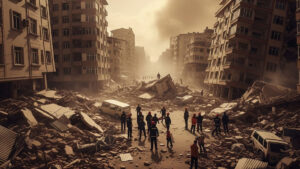https://theworldfinancialforum.com/participate/
Multi-agency disaster The National Disaster Management Authority (NDMA), in collaboration with the Indian Army and the state governments of Delhi, Haryana, and Uttar Pradesh, is set to conduct a large-scale disaster management exercise named “Exercise Suraksha Chakra” from July 29 to August 1, 2025.
This multi-agency, multi-state drill is among the most extensive disaster preparedness initiatives ever conducted in the National Capital Region (NCR), aimed at strengthening inter-agency coordination and response mechanisms to handle major disasters such as earthquakes and industrial chemical hazards.
The four-day exercise is structured to progress from strategic planning to ground-level action. On July 29, a high-level symposium will be held at the Manekshaw Centre, where senior leadership from participating agencies will deliberate on the hazard profile of the region and share strategies for effective disaster response.
This will be followed by a Table Top Exercise (TTEx) on July 30 at the same venue, during which disaster managers will simulate and wargame their response plans against hypothetical disaster scenarios.
The exercise will culminate on August 1 with a full-scale mock drill simulating a major earthquake event. This field-level exercise will be conducted simultaneously across all 18 participating districts in the NCR and coordinated by the Delhi State Disaster Management Authority (SDMA).
A public advisory has been issued in advance of the August 1 mock drill to ensure that residents do not mistake the exercise for an actual emergency. Citizens are urged to stay calm and cooperate with authorities, as the activities are designed solely for preparedness and training purposes.
During the exercise, people may witness increased movement of emergency vehicles, including ambulances, fire tenders, police vehicles, and army trucks. Response teams comprising personnel from the National Disaster Response Force (NDRF), Armed Forces, Civil Defence, and other participating agencies will be deployed in various locations.
Sirens and public address systems may be used to signal the commencement of the drill and temporary field facilities such as Incident Command Posts, Staging Areas, Relief Camps, and Medical Aid Posts will be set up at designated sites. Simulated rescue operations involving search and rescue drills, casualty evacuation and medical aid will also be conducted using mock victims to test emergency response capabilities.
The exercise will span 18 districts in the NCR, including all 11 districts of Delhi—Central, East, New Delhi, North, North East, North West, Shahdara, South, South East, South West, and West Delhi. From Haryana, the participating districts are Gurugram, Faridabad, Palwal, Nuh, and Rewari, while Gautam Buddha Nagar and Ghaziabad are the two participating districts from Uttar Pradesh.
EXERCISE SURAKSHA CHAKRA adopts a “Whole-of-Government” approach, with participants including the Armed Forces, Central Armed Police Forces (CAPFs), scientific and technical institutions such as the India Meteorological Department (IMD) and the National Centre for Seismology (NCS), as well as civil society organisations.
– Ends
